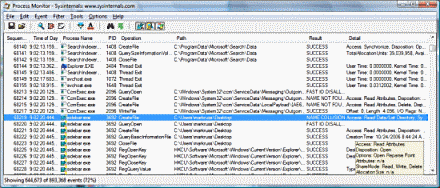
We talk about their new tool - Sysinternals System Monitor. System Monitor (Sysmon) is a Windows system servic Mark Russinovich and Thomas Garnier join Andrew Richards in this episode of Defrag Tools. Process Monitor (procmon) is an advanced monitoring tool for Windows that shows real-time file system, Registry and process/thread activity. Procmon will not collect certain Auto-Protect events. For instructions on how to do so, please see Document ID TECH98079, 'How to Configure Sysinternals' Process Monitor to Record Symantec's Auto.
Sysinternals Process Tools Descriptions and Information The Sysinternals web site was created in 1996 by Mark Russinovich and Bryce Cogswell to host their advanced system utilities and technical information. Microsoft acquired Sysinternals in July, 2006. These tools are not loaded on Windows operating systems by default. They can be downloaded from or The site has the latest public builds of the tools and is more up to date than the site.
All examples are based on at least Process Explorer version 11.31.0.0 and Process Monitor 2.3.0.0. There is no installer/uninstall for these tools. The first time the programs are run, the EULA will display, after accepting the EULA the first time, this screen should not reappear. The tools can also be run straight from the web using the following format:.
You can also map a drive letter right to the public location by running SUBST drive: live.sysinternals.com tools although this may not work when a proxy server is set. I9060 flash by sp flash tool. Process Monitor (Process Monitor.exe) Monitors File, Registry, network and process activity by process.
Collects data when running and can be filtered to track down process issues. Process Monitor replaces FileMon and RegMon, except for back level operating systems. Process Monitor runs on Windows 2000 SP4, XP SP2, Vista, 2003, 2008 and Windows 7 32 bit and 64 bit. Process Monitor does not run on Windows 2000 pre SP4 and may not always be able to be used to troubleshoot SharePoint Portal Server 2001. You must use Filemon and Regmon to monitor Windows 2000 and SharePoint Portal Server 2001; if Process Monitor does not run on you server.
These can be downloaded from the Sysinternals TechNet site,. Some of the command-line switches are below. Refer to the Procmon.chm file for a complete list. /Openlog Directs Process Monitor to open and load the specified log file. /Noconnect When this flag is present Process Monitor does not automatically start logging activity.
/AcceptEula Automatically accepts the license and bypasses the EULA dialog. /Quiet Don't confirm filter settings on startup. /Run32 Use this switch to run the 32-bit version of Process Monitor on 64-bit Windows to open logs generated on 32-bit systems *Note: If you are going to open a.PML log file from a 32 bit computer on a 64 bit Windows computer you will need to enter the /Run32 switch to view the log, or you will get the following error when trying to open the log file.
Process Monitor User Interface By default, Process Monitor uses virtual memory to store captured data. Use the Backing Files dialog, which you access from the File menu, to configure Process Monitor to store captured data in files on disk.
Enabling this option has Process Monitor log data to the disk in its native PML format as it captures it. If running a long capture you can set the logging to a backing file, File->Backing Files Profiling This event class can be enabled from the Options menu. When active, Process Monitor scans all the active threads in the system and generates a profiling even for each one that records the kernel and user CPU time consumed, as well as the number of context switches executed, by the thread since its previous profiling event.
Note: the System process is not included in profiling. Profiling Events Use this menu entry to open the thread profiling configuration dialog, where you enable thread profiling and the rate at which thread profiling events generate.
When thread profiling is enabled, Process Monitor captures thread stack traces and CPU utilization that you can use to identify the source of CPU-related performance issues. Process Explorer (Process Explorer.exe) Monitors data on running processes in real time, does not capture historical data, except for CPU, Disk, Page File and Network activity graphs. The data in the graphs cannot be saved. Process Explorer can be used to view detailed information on the currently running process on a system; including which images or executable code is loaded in memory for a process and the handles to the registry, file system and other types of handles. You can also change the priority; suspend and kill processes and even certain threads of a process. Some of the command-line switches are below.
Refer to the Procexp.chm file for a complete list.